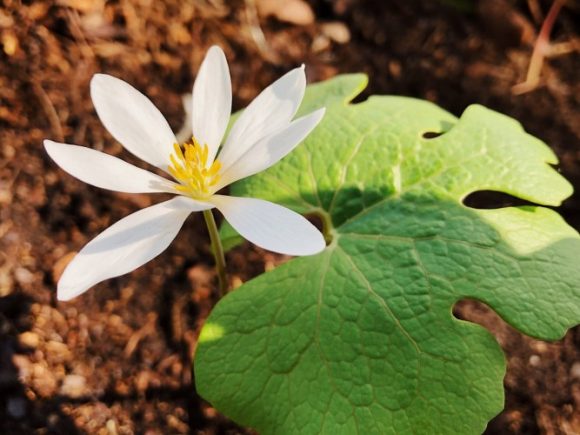- The Miraculous Shiny Bush Plant - January 18, 2021
- Colorful, Edible and Medicinal Celosia - January 10, 2021
- Radish, a Nutritional Power House - December 19, 2020
Sanguinaria Canadensis, commonly known as bloodroot, pauson, and redroot is a perennial, flowering herb native to North America. The plant is the only species in the Sanguinaria genus and is closely related to eomecon of Asia. It blooms from March to May depending on the weather or region, featuring 8-12 white petals with many yellow stamens, and 2 sepals beneath the petals. The flowers open when exposed to sunlight and close at dusk. Bloodroot plant medicinal uses were first exploited by Native Americans but with time the plant was adopted in other regions as more people discovered its herbal properties.
[Note: The Right Flowers is not a medical site. Knowledge of and information about the therapeutic benefits and applications of flowers, while known through the ages, does not constitute medical advice. If you are having health issues, you should consult with a physician.]
Dental health
Research shows that bloodroot is ideal in treating and preventing gum infections including gingivitis. It may also assist in reducing plaque which often leads to gum infection. One study in Phytotherapy Research indicates that using dental cleaning products containing bloodroot extracts was more effective in preserving dental health compared to using products without the plant’s extracts.
Cancer treatment and prevention
One of the substances found in bloodroot is berberine. The compound is said to reduce the size of cancerous cells in prostate cancer. Berberine is also known to prevent and treat many other cancers including skin and breast cancer. In addition, emerging evidence shows that bloodroot has the ability to inhibit tumor growth, meaning it can prevent some types of cancer. Though most of the studies of cancer prevention and treatment have been conducted on animal models, the plant holds a lot of potential in treating cancer in humans.
Respiratory health
Bloodroot is commonly used to treat common colds, flu, sinus and lung infections. It may also act as an expectorant to clear congested airways in the body. In addition, studies show that bloodroot has inotropic agents which increase the strength of muscular contractions in the heart muscle, which treats and prevents respiratory problems.
Skin care
Bloodroot is used in many skin care products due to its high concentration of anti-inflammatory and antioxidant properties. It treats and reduces the effects of a wide range of skin problems including psoriasis, skin lesions, eczema, and warts. Lotions and ointments containing bloodroot extracts are also good in reducing the effects of premature aging and managing acne.
Analgesic
Bloodroot seems to have analgesic properties. As a result, it is great for easing migraines and headaches. Since it works by reducing inflammation, the plant is also useful in managing pain caused by arthritis. Extracts from the plant enhance blood circulation, stimulate growth and keep the metabolism healthy which enables people suffering from chronic pain to remain active and enjoy their daily life.
Ultimately, the many bloodroot plant medicinal uses have given bloodroot a home in many gardens as more people cultivate it in order to benefit from its extracts.





